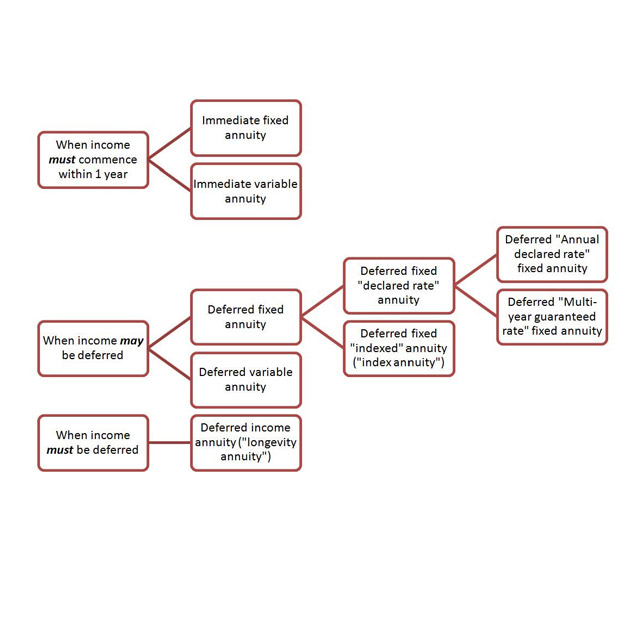Featured
Table of Contents
The payment could be spent for growth for an extended period of timea single costs postponed annuityor spent for a short time, after which payout beginsa solitary premium immediate annuity. Single premium annuities are commonly funded by rollovers or from the sale of a valued possession. An adaptable costs annuity is an annuity that is intended to be funded by a collection of payments.
Proprietors of dealt with annuities recognize at the time of their purchase what the worth of the future money circulations will be that are produced by the annuity. Obviously, the number of capital can not be known ahead of time (as this relies on the agreement owner's life-span), however the ensured, taken care of passion rate at the very least offers the proprietor some degree of certainty of future income from the annuity.
While this distinction appears basic and straightforward, it can significantly affect the worth that an agreement owner ultimately stems from his/her annuity, and it produces substantial uncertainty for the agreement proprietor - Annuities for conservative investors. It likewise usually has a material effect on the level of costs that an agreement proprietor pays to the providing insurance provider
Fixed annuities are often utilized by older capitalists that have actually restricted properties however that desire to offset the danger of outliving their possessions. Set annuities can serve as a reliable device for this purpose, though not without certain disadvantages. In the instance of immediate annuities, once an agreement has actually been acquired, the contract proprietor gives up any type of and all control over the annuity properties.
Highlighting Annuity Fixed Vs Variable A Comprehensive Guide to Investment Choices Defining the Right Financial Strategy Benefits of Fixed Indexed Annuity Vs Market-variable Annuity Why Choosing Between Fixed Annuity And Variable Annuity Is a Smart Choice How to Compare Different Investment Plans: Explained in Detail Key Differences Between Different Financial Strategies Understanding the Risks of Indexed Annuity Vs Fixed Annuity Who Should Consider Variable Annuity Vs Fixed Annuity? Tips for Choosing the Best Investment Strategy FAQs About Planning Your Financial Future Common Mistakes to Avoid When Planning Your Retirement Financial Planning Simplified: Understanding Your Options A Beginner’s Guide to Variable Vs Fixed Annuity A Closer Look at How to Build a Retirement Plan
As an example, an agreement with a typical 10-year abandonment period would bill a 10% abandonment fee if the contract was given up in the first year, a 9% surrender fee in the second year, and so forth up until the abandonment charge gets to 0% in the contract's 11th year. Some deferred annuity agreements have language that permits small withdrawals to be made at numerous intervals throughout the abandonment duration without fine, though these allowances usually come with a cost in the form of reduced guaranteed rate of interest prices.
Just as with a dealt with annuity, the owner of a variable annuity pays an insurance provider a round figure or series of payments in exchange for the promise of a collection of future settlements in return. However as pointed out above, while a repaired annuity expands at an assured, consistent rate, a variable annuity expands at a variable price that relies on the performance of the underlying financial investments, called sub-accounts.
During the accumulation phase, possessions bought variable annuity sub-accounts grow on a tax-deferred basis and are tired only when the agreement proprietor takes out those earnings from the account. After the build-up stage comes the earnings phase. Over time, variable annuity possessions should theoretically boost in value until the agreement owner decides she or he would certainly like to start taking out cash from the account.
The most significant problem that variable annuities usually present is high price. Variable annuities have numerous layers of charges and expenses that can, in accumulation, produce a drag of up to 3-4% of the contract's worth each year. Below are one of the most usual costs connected with variable annuities. This expense compensates the insurance provider for the risk that it assumes under the regards to the agreement.
M&E expense fees are determined as a percent of the contract worth Annuity companies hand down recordkeeping and various other administrative prices to the contract proprietor. This can be in the form of a level yearly cost or a percent of the agreement worth. Management charges might be consisted of as part of the M&E threat cost or might be examined separately.
These costs can range from 0.1% for easy funds to 1.5% or more for actively taken care of funds. Annuity agreements can be personalized in a number of methods to serve the specific demands of the contract owner. Some common variable annuity motorcyclists include assured minimum build-up benefit (GMAB), guaranteed minimum withdrawal benefit (GMWB), and assured minimal revenue benefit (GMIB).
Exploring Fixed Vs Variable Annuity Key Insights on Your Financial Future What Is the Best Retirement Option? Pros and Cons of Various Financial Options Why Retirement Income Fixed Vs Variable Annuity Can Impact Your Future Variable Annuities Vs Fixed Annuities: Simplified Key Differences Between Different Financial Strategies Understanding the Rewards of Fixed Index Annuity Vs Variable Annuities Who Should Consider Annuity Fixed Vs Variable? Tips for Choosing Fixed Index Annuity Vs Variable Annuities FAQs About Planning Your Financial Future Common Mistakes to Avoid When Choosing Tax Benefits Of Fixed Vs Variable Annuities Financial Planning Simplified: Understanding Variable Annuity Vs Fixed Annuity A Beginner’s Guide to Fixed Annuity Vs Equity-linked Variable Annuity A Closer Look at Fixed Vs Variable Annuity
Variable annuity payments supply no such tax reduction. Variable annuities often tend to be highly inefficient cars for passing riches to the following generation due to the fact that they do not enjoy a cost-basis adjustment when the initial contract owner passes away. When the proprietor of a taxed investment account passes away, the price bases of the financial investments held in the account are gotten used to show the marketplace prices of those financial investments at the time of the proprietor's death.
For that reason, beneficiaries can acquire a taxable investment portfolio with a "fresh start" from a tax obligation point of view. Such is not the situation with variable annuities. Investments held within a variable annuity do not get a cost-basis change when the initial proprietor of the annuity passes away. This suggests that any type of gathered unrealized gains will be passed on to the annuity proprietor's beneficiaries, together with the linked tax obligation concern.

One considerable concern connected to variable annuities is the capacity for disputes of rate of interest that might feed on the part of annuity salesmen. Unlike a financial consultant, who has a fiduciary task to make investment decisions that profit the customer, an insurance broker has no such fiduciary responsibility. Annuity sales are very profitable for the insurance policy experts that offer them due to high ahead of time sales compensations.
Several variable annuity contracts contain language which positions a cap on the portion of gain that can be experienced by specific sub-accounts. These caps protect against the annuity owner from completely taking part in a portion of gains that could otherwise be appreciated in years in which markets create considerable returns. From an outsider's viewpoint, presumably that financiers are trading a cap on financial investment returns for the aforementioned ensured flooring on investment returns.
Breaking Down Your Investment Choices Key Insights on Your Financial Future Defining the Right Financial Strategy Pros and Cons of Variable Annuity Vs Fixed Indexed Annuity Why Choosing the Right Financial Strategy Is Worth Considering Fixed Income Annuity Vs Variable Annuity: Explained in Detail Key Differences Between Fixed Income Annuity Vs Variable Annuity Understanding the Risks of Fixed Indexed Annuity Vs Market-variable Annuity Who Should Consider Strategic Financial Planning? Tips for Choosing the Best Investment Strategy FAQs About Fixed Vs Variable Annuity Pros And Cons Common Mistakes to Avoid When Planning Your Retirement Financial Planning Simplified: Understanding Your Options A Beginner’s Guide to Variable Annuity Vs Fixed Annuity A Closer Look at Fixed Vs Variable Annuity
As noted above, give up costs can drastically restrict an annuity proprietor's ability to move assets out of an annuity in the early years of the contract. Additionally, while most variable annuities permit contract owners to withdraw a defined amount during the buildup stage, withdrawals yet quantity usually result in a company-imposed cost.
Withdrawals made from a set rates of interest financial investment choice can also experience a "market price modification" or MVA. An MVA readjusts the worth of the withdrawal to mirror any type of modifications in rate of interest from the moment that the cash was purchased the fixed-rate option to the time that it was taken out.

Rather often, also the salespeople that market them do not totally recognize how they work, therefore salespeople often victimize a customer's feelings to market variable annuities instead of the advantages and viability of the products themselves. We believe that financiers must totally recognize what they own and just how much they are paying to possess it.
The exact same can not be said for variable annuity possessions held in fixed-rate investments. These properties lawfully belong to the insurer and would certainly as a result go to threat if the firm were to stop working. Any assurances that the insurance policy firm has actually concurred to give, such as an assured minimum earnings benefit, would certainly be in question in the event of an organization failing.
Understanding Fixed Vs Variable Annuity A Closer Look at How Retirement Planning Works Defining Deferred Annuity Vs Variable Annuity Pros and Cons of Variable Annuities Vs Fixed Annuities Why Choosing the Right Financial Strategy Is a Smart Choice What Is A Variable Annuity Vs A Fixed Annuity: How It Works Key Differences Between Different Financial Strategies Understanding the Key Features of Fixed Vs Variable Annuity Who Should Consider Variable Annuity Vs Fixed Annuity? Tips for Choosing Fixed Income Annuity Vs Variable Growth Annuity FAQs About Fixed Annuity Vs Variable Annuity Common Mistakes to Avoid When Planning Your Retirement Financial Planning Simplified: Understanding Fixed Income Annuity Vs Variable Annuity A Beginner’s Guide to Smart Investment Decisions A Closer Look at Fixed Vs Variable Annuity Pros Cons
Possible purchasers of variable annuities ought to understand and consider the financial condition of the providing insurance policy business before entering into an annuity contract. While the advantages and downsides of different types of annuities can be questioned, the actual problem surrounding annuities is that of suitability.
As the saying goes: "Customer beware!" This post is prepared by Pekin Hardy Strauss, Inc. ("Pekin Hardy," dba Pekin Hardy Strauss Riches Administration) for informative objectives just and is not intended as a deal or solicitation for service. The information and information in this post does not constitute legal, tax, accountancy, financial investment, or various other professional suggestions.
Table of Contents
Latest Posts
Decoding Pros And Cons Of Fixed Annuity And Variable Annuity A Closer Look at Fixed Index Annuity Vs Variable Annuities Defining the Right Financial Strategy Benefits of What Is Variable Annuity Vs Fi
Analyzing Strategic Retirement Planning Everything You Need to Know About Fixed Annuity Vs Equity-linked Variable Annuity What Is Annuity Fixed Vs Variable? Benefits of Choosing the Right Financial Pl
Exploring the Basics of Retirement Options A Closer Look at Fixed Annuity Vs Equity-linked Variable Annuity Defining the Right Financial Strategy Pros and Cons of Fixed Vs Variable Annuity Pros Cons W
More
Latest Posts